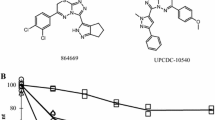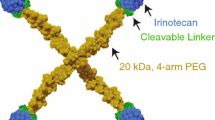Abstract
The MEK–mitogen-activated protein kinase (MAPK) signal transduction pathway is involved with numerous cellular processes including cell growth and differentiation. Phosphorylation of MAPK (pMAPK) by MEK results in activation of this pathway. In various solid tumors, the MEK–MAPK pathway is constitutively active; therefore inhibition of this pathway may provide a therapeutic strategy for treating cancer. The objective of this study was to determine the extent and duration of inhibition of pMAPK in selected normal tissues in rats following single oral or intravenous (IV) doses of the novel MEK inhibitor, PD0325901. Male Sprague–Dawley rats (9/group) received either single oral (PO) or IV doses of PD0325901 at 10, 30, or 100 mg/kg (60, 180, and 600 mg/m2, respectively). Controls received vehicle alone which was aqueous 0.5% hydroxypropylmethyl-cellulose/0.2% Tween 80 for PO dosing and 20% beta-cyclodextran sulfobutyl ether in water (w:v) for IV dosing. Animals (3/group/day) were euthanized on Days 2, 3, and 4, at approximately 24, 48, and 72 h after dosing, respectively. The effects on pMAPK in liver and lung were determined by Western blot analysis and compared with plasma PD0325901 levels. Satellite animals (6/dose/route) received single PO or IV doses and serial blood samples were collected for determination of toxicokinetic parameters of PD0325901 and its major metabolite. In general, systemic exposure to PD0325901 was comparable between routes of administration due to high PO bioavailability (56–109%). Plasma area under the concentration–time curve values of the pharmacologically inactive carboxylic acid metabolite ranged from 18 to 40% of PD0325901. Clinical signs of toxicity occurred at 100 mg/kg PO or IV, indicating the maximum-tolerated dose had been achieved. On Day 2, pMAPK was inhibited 57–95% in liver and 86–99% in lung at all doses, irrespective of route of administration. On Day 3, lung pMAPK remained inhibited 75–91% at all IV doses and by 88% after the 100-mg/kg PO dose. Liver pMAPK remained inhibited 79 and 91% on Day 3 after 100 mg/kg by IV and PO doses, respectively. On Day 4, liver pMAPK was still inhibited 66% after the 100-mg/kg PO dose. The EC50 and EC90 plasma drug levels for inhibition of lung pMAPK were calculated to be 20 and 99 ng/ml, respectively. Liver pMAPK levels were inhibited at least 50% at plasma PD0325901 concentrations ≥50 ng/ml. In conclusion, single PO or IV doses of PD0325901 resulted in dose-dependent inhibition of pMAPK in liver and lung. Inhibition of pMAPK in liver was comparable between routes of administration at ≤30 mg/kg, whereas inhibition of pMAPK in lung occurred for a longer duration following IV administration. Measurement of pMAPK in normal tissues served as a means for assessing the pharmacologic activity of PD0325901 and should be included in toxicity studies to evaluate toxicity–pharmacology relationships.






Similar content being viewed by others
References
Allen LF, Sebolt-Leopold J, Meyer MB (2003) CI-1040 (PD184352), a targeted signal transduction inhibitor of MEK (MAPKK). Semin Oncol 30(5 Suppl. 16):105–116
Brown AP, Courtney C, Carlson T, Graziano M (2005) Administration of a MEK inhibitor results in tissue mineralization in the rat due to dysregulation of phosphorus and calcium homeostasis. Toxicologist 84(S-1):108 (abstract 529)
Dent P, Grant S (2001) Pharmacologic interruption of the mitogen-activated extracellular-regulated kinase/mitogen-activated protein kinase signal transduction pathway: potential role in promoting cytotoxic drug action. Clin Cancer Res 7:775–783
Gelmon KA, Eisenhauer EA, Harris AL, Ratain MJ, Workman P (1999) Anticancer agents targeting signaling molecules and cancer cell environment: challenges for drug development? J Natl Cancer Inst 91(15):1281–1287
Hoshino R, Chatani Y, Yamori T, et al (1999) Constitutive activation of the 41-/43-kDa mitogen-activated protein kinase pathway in human tumors. Oncogene 18:813–822
Jarvis WD, Auer KL, Spector M, et al (1997) Positive and negative regulation of JNK1 by protein kinase C and p42MAP kinase in adult rat hepatocytes. FEBS Lett 412:9–14
Koup JR, Liu J, Loi CM, et al (2004) PK/PD modeling of biomarker (p-ERK) response and tumor growth to PD0325901 in a human tumor xenograft mouse model. Proc Am Assoc Cancer Res 45:1248 (abstract 5409)
LoRusso P, Krishnamurthi S, Rinehart JR, et al (2005) A phase 1–2 clinical study of a second generation oral MEK inhibitor, PD0325901 in patients with advanced cancer. Proc Am Soc Clin Oncol (abstract 3011)
Luo FR, Yang Z, Dong H, et al (2005) Prediction of active drug plasma concentrations achieved in cancer patients by pharmacodynamic biomarkers identified from the Geo human carcinoma xenograft model. Clin Cancer Res 11(15):5558–5565
Mansour SJ, Matten WT, Hermann AS, et al (1994) Transformation of mammalian cells by constitutively active MAP kinase kinase. Science 265:966–970
Mendel DB, Laird AD, Xin X, et al (2003) In vivo antitumor activity of SU11248, a novel tyrosine kinase inhibitor targeting vascular endothelial growth factor and platelet-derived growth factor receptors: determination of a pharmacokinetic/pharmacodynamic relationship. Clin Cancer Res 9:327–337
Milella M, Kornblau SM, Estrov Z, et al (2001) Therapeutic targeting of the MEK/MAPK signal transduction module in acute myeloid leukemia. J Clin Invest 108(6):851–859
Peralba JM, deGraffenried L, Friedrichs W, Fulcher L, Grunwald V, Weiss G, Hidalgo M (2003) Pharmacodynamic evaluation of CCI-779, an inhibitor of mTOR, in cancer patients. Clin Cancer Res 9:2887–2892
Rinehart J, Adjei AA, LoRusso PM, et al (2004) Multicenter phase II study of the oral MEK inhibitor, CI-1040, in patients with advanced non-small-cell lung, breast, colon, and pancreatic cancer. J Clin Oncol 22(22):4456–4462
Sebolt-Leopold JS (2000) Development of anticancer drugs targeting the MAP kinase pathway. Oncogene 19:6594–6599
Sebolt-Leopold J (2003) Pfizer Global Research and Development internal publication. Summary of the preclinical pharmacology of PD0325901-0000. RR-REG 761-00063, October 28, 2003
Sebolt-Leopold JS, Dudley DT, Herrera R, et al (1999) Blockade of the MAP kinase pathway suppresses growth of colon tumors in vivo. Nat Med 5(7):810–816
Sebolt-Leopold JS, Merriman R, Omer C, et al (2004) The biological profile of PD0325901: a second generation analog of CI-1040 with improved pharmaceutical potential. Proc Am Assoc Cancer Res 45:925 (abstract 4003)
Solit DB, Garraway LA, Pratilas CA, et al (2006) BRAF mutation predicts sensitivity to MEK inhibition. Nature 439:358–362
Author information
Authors and Affiliations
Corresponding author
Rights and permissions
About this article
Cite this article
Brown, A.P., Carlson, T.C.G., Loi, CM. et al. Pharmacodynamic and toxicokinetic evaluation of the novel MEK inhibitor, PD0325901, in the rat following oral and intravenous administration. Cancer Chemother Pharmacol 59, 671–679 (2007). https://doi.org/10.1007/s00280-006-0323-5
Received:
Accepted:
Published:
Issue Date:
DOI: https://doi.org/10.1007/s00280-006-0323-5




